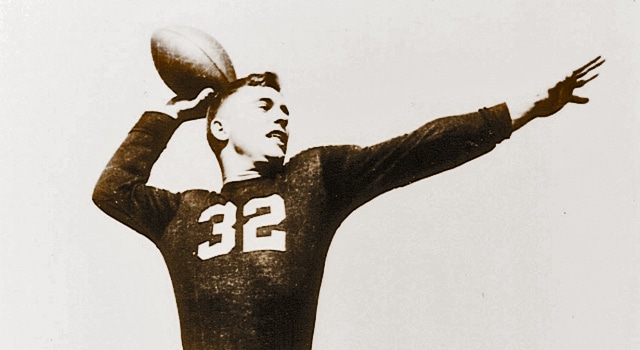#2 Johnny Lujack: Notre Dame Football’s Top 25 Players

#2 Johnny Lujack, QB/DB 1942-1943, 1946-1947
Connelsville’s All-American Boy
Johnny Lujack was born in Connellsville on January 3, 1925. He was born under a good sign as that was just 3 days after Rock and the Four Horsemen had defeated Pop Warner, Ernie Nevers and the Stanford Indians in the Rose Bowl.
Lujack checked every box growing up in Connellsville.
He was Connellsville’s favorite son as the community, sensing the gathering storm first, then reeling from Pearl Harbor, wanted him to accept an appointment from West Point.
He excelled in the classroom and was the Valedictorian of his graduating class at Connellsville.
He was revered by his fellow students as he was elected Class President.
He danced every athletic dance they had, starring in football, basketball and baseball.
Frank Leahy had taken over the reins at Notre Dame in 1941 and was about to convert from the Box formation to the split-T. Lujack would be a perfect fit in the split-T and at Notre Dame. Lujack agreed and headed to South Bend.
Learning and Waiting
Lujack bided his time as a frosh in ’42, being part of the installation of the Split-T and learning from the artful Bertelli. The outstanding student absorbed every bit of Leahy’s wisdom and tactics.
Next Man In – 1943
Substitute quarterbacks have been important at Notre Dame, but no one hung the moon coming off the bench like Lujack. Angelo Bertelli, on a collision course with the Heisman Trophy in ’43, left to accept a collision course with the Axis powers after the 6th game.
Lujack grabbed a helmet, trotted onto the field, and never looked back. The only loss he ever quarterbacked at Notre Dame was to Paul Brown’s mighty Great Lakes Naval Training Station team by a 19-14 score in ‘43’s last game. Lujack scored 7 points a game in his 4 starts in 1943
Lujack never needed a next man in. His record for the remainder of his career was 20-1-1 and his Notre Dame teams outscored opponents 29-5.
As tough in the Channel as on the Football Field
The denizens of Connellsville had urged Lujack to serve the military by going to West Point. He chose the Navy and, as an ensign, chased Nazi subs in the English Channel. God, Country, Notre Dame.
Back to Notre Dame
Lujack returned in 1946 to a loaded roster, but Leahy knew who his quarterback would be – Lujack. He was a mature, battle-tested 21 year old junior, the master of all he surveyed.
Did Lujack Make the Most Significant Play in Notre Dame History?
Only the Michigan State-Notre Dame game of 1966 had the pregame attention that visited the Notre Dame Army game of 1946, and that was the first time America could exhale after VE and VJ day.
Leahy’s defense had kept Army’s two Heisman studs, Blanchard and Davis, contained, but suddenly, Blanchard broke lose and Irish subway alums’ hearts stopped. But Lujack saved the play, the game, the 0-0 final score and the magical four year Leahy run. Lujack is remember for his quarterbacking, but is revered by Leahy era fans for the tackle against Blanchard, bringing him down as if he were a Third Reich sub in the English Channel.
https://www.youtube.com/watch?v=sXjV4cUKQAs
The grainy footage hardly captures the drama of the moment. It was the pivot for the game, the season, and the entire dynasty.
Did Lujack Lead the Greatest Team in Notre Dame History?
Most experts felt that the 1947 team was the most dominant squad ever in Notre Dame’s revered history. They ran roughshod over the nation’s toughest schedule.
Lujack was about winning rather than stats. He could certainly pass, as he proved when he threw for a then NFL record 458 yards for the Bears, but he distributed the ball and controlled the offense, completing 61 passes for 778 yards in 1947. The dominant Irish were always ahead, and seldom needed to pass. They outscored opponents 291-52.
Lujack’s Heisman Trophy
Johnny Lujack had finished third in the Heisman Trophy voting in 1946 behind Army’s Glenn Davis and Charley Trippi then easily won it in 1947. He was the second Irish Heisman winner after Angelo Bertelli in 1943. The quarterback depth chart is solid when you have two Heisman trophy winners on the two deep.
Lujack fulfilled all the promise he’d shown in Connellsville, on the gridiron, in the English Channel and in the court of public opinion.
Go Irish!




Heres to Johnny Lujack#32!